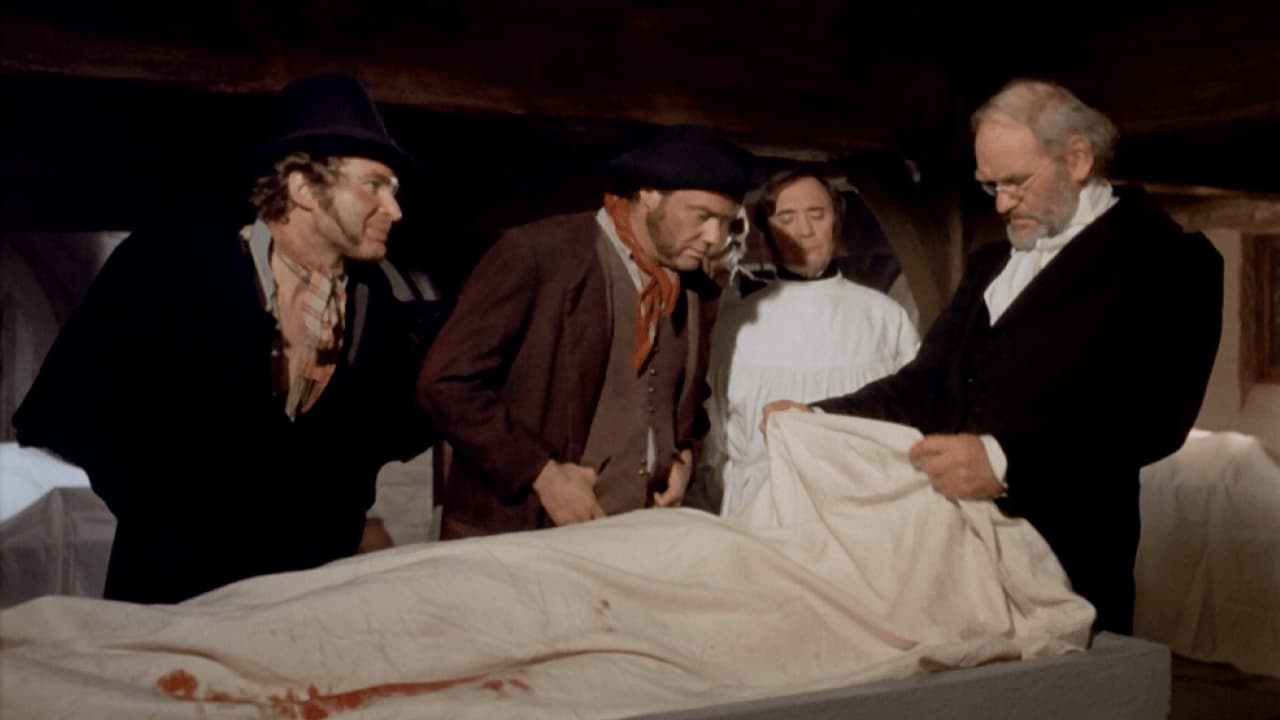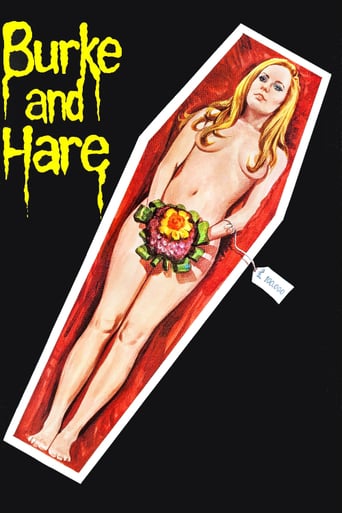

This movie is absolutely awful. Not sure if they are going for a humorous feel or if it is just really badly made, but it is not funny. It is definitely raunchy so maybe some people will like it for that. The title song that plays a few times during this movie is silly and poorly done, and very much speaks to the quality of the rest of this movie. I only watched this because Danish actress Stensgaard is in this and she was quite good in Lust for a Vampire. She was decent in this though not one of the main stars. She didn't save it. Just one poorly made scene I will discuss because it really stood out as bad was when one couple was kissing and the woman stops and screams at her lover out of the blue, for no apparent reason. I give many thumbs down on this piece of rubbish.
... View MoreThis lively retelling of the Burke and Hare story is entertaining enough, and also refreshingly light-hearted (funny how they always are, considering the macabre subject matter) enough to entertain the viewer throughout. It's an undeniably British film, packed with swearing, sweaty characters and loads of tame sleaze. Some scenes in this film actively resemble those cheeky sex comedies of the '70s which our country churned out, containing as they do men and women romping about in bedrooms in various states of undress.All characters in the story are present and correct, with Glynn Edwards and Derren Nesbitt actually doing very well as the eponymous duo. This pair really convey the whole sleaziness/perversity of the subject, and do so in a funny way, too; it's a good double-act. Only a painfully low budget lets the film down, robbing us of an actual ending in the meantime as well: we all know what's going to happen, but the film cuts to a drawing while the conclusion is narrated! It's a letdown, but for the majority this film is great fun.Harry Andrews is on hand to ham it as Dr Knox, here wearing an eye-patch. Sadly Knox is given little screen time in this film, as the title would suggest, although he has a fine line in crude humour. He's a long way from Cushing's spot-on performance in THE FLESH AND THE FIENDS, and it's sad to see such a great actor falling on hard times. Some other familiar faces pop up in the cast, including sitcom favourite Yootha Joyce who plays Edwards' long-suffering and occasionally murderous wife. Hammer fans will also spot LUST FOR A VAMPIRE's Yutte Stensgaard romping about half naked in one of the film's many brothel scenes, all part of a subplot included just to show lots of topless women; the stunning Francoise Pascal is also willing to oblige in this respect. Far too much screen time is also spent on some foppish medical students who get up to all sorts of sordid affairs after hours.The actual scenes of grave-robbing are dealt with accordingly, i.e. with heaps of macabre relish, although THE COMEDY OF TERRORS will always be the king of ghoulish humour in this respect. There's also a knack for detail as well, with many of the characters speaking in Scottish accents, which makes for a refreshing change. All over, this is a fun little film with plenty of spirit, which only occasionally lapses uncomfortably, and has a mischievous air about it impossible to dislike. And check out that catchy song by The Scaffold (the guys who sang Lily the Pink, no less!) which plays over the opening and closing credits!
... View MoreFairly maligned but, in retrospect, reasonably enjoyable version of the notorious body-snatching double act – played here by Derren Nesbitt (a regular in director Sewell's work) and Glynn Edwards (surprisingly, for a title role, played by a prolific character actor rather than a star or even a familiar face); both men are now married and their spouses get wind of their nefarious activities before long. The end is also closer to the truth, with Hare turning State's Evidence (eventually dying blind and destitute), leaving Burke to hang alone, and Dr. Knox (a typically full-blooded Harry Andrews, with an eye-patch over his right eye and given to cracking dirty jokes for his colleagues' amusement!) – the eminent surgeon they sold the bodies to – being expelled from his profession but subsequently setting up a traveling medicine show! Oddly enough, the rivalry between Knox and the other surgeon-lecturers is all but inexistent here! The style is agreeably redolent of Hammer Films (nicely book-ended by recreations of period illustrations dealing with the case), though like the brand-new John Landis rendition, the tone is bawdily comic rather than the sleazy seriousness adopted by two more British treatments of these events (unfolding in 1820s Edimburgh) by notable directors – John Gilling's THE FLESH AND THE FIENDS (1959) and Freddie Francis' THE DOCTOR AND THE DEVILS (1985), both of which I had reviewed soon after their first viewing. For the record, the screenplay is the handiwork of Ernle Bradford; his major claim to fame was penning the bestselling chronicle of The Great Siege of Malta of 1565 and, not only is a street in my hometown named after him, but he was to die on our shores in 1986!The brothel scenes (ostensibly demonstrating Knox's students' leisure time, as well as provide convenient victims for the titular duo, but all-too-obviously mandated by the new-fangled permissiveness) feel rather like padding – incidentally, former Hammer starlet Yutte Stensgaard appears briefly as one such prostitute (which she unconvincingly plays drunk much of the time!). One unexpected asset, however, is a rollicking folk-tune sung by The Scaffold during the film's opening and closing titles.I do not know if the copy I acquired is culled from the film's DVD edition (through Redemption) but it came accompanied by an interesting 12-minute 'lecture' featuring an unusual-looking (displaying tattoos and piercings galore!) female Professor who, amongst other things, parallels the real-life Dr. Knox's dabbling in body parts so that others may live with the literary figure of Baron Frankenstein attempting to re-animate composites of dead tissue (especially since both came by them illegally).
... View MoreThis is the fourth in a total of five film-versions revolving of the factual Burke & Hare murders and, although certainly not as mesmerizing and memorable as "The Flesh and the Fiends" (1959) or "The Body Snatcher" (1945), Vernon Sewell's interpretation of this macabre page in Scottish history is still a truly engaging and at times even frightening movie. It's actually unfair to compare this version with the aforementioned titles, as both those films starred famous names and perhaps even had a bit more financial means to work with. This is clearly a low-budgeted film with a very limited amount of set pieces and make-up effects, and relies mainly on atmosphere and a sinister choreography. To those that aren't really familiar with the story yet, William Burke and William Hare were two poor immigrants in Victorian Edinburgh that discovered a rather unorthodox way to get rich really fast. As cadaver-suppliers to the eminent anatomist/university professor Dr. Knox, they specialized in delivering the "freshest" corpses of all body snatchers. Of course, to keep assuring this service they quickly had to turn to murder. The main reason why "Horrors of Burke and Hare" is weaker than the other versions is because the story contains too many irrelevant elements and doesn't focuses enough on the known facts. Numerous sequences inside the fancy brothel are pretty redundant (albeit entertaining), whereas other very important aspects are seemly ignored. Like the actual interactions between Dr. Knox and his corpse suppliers, for example, or the men's dangerously increasing greed and immorality. Also, and this for the very first time, the wives of Burke and Hare are involved in the murders and I can't remember having read anything about this being the case. There's quite a lot of sleaze and gorgeous female nudity on display, which make the inaccuracy so much more endurable. Particularly the unearthly beautiful Yutte Stensgaard (the blond prostitute) and Françoise Pascal (the brunette) deserve a special mentioning. This film has its very own and totally unique title-song and that's arguable the greatest thing about it! It's an uncanny song, rather vulgarly sung and warning us all to BEWARE of Burke & Hare. Perhaps not the best movie ever made, "The Horrors of Burke and Hare" is certainly on par with most contemporary British horror films (and actually better than Vernon Sewell's other films "The Curse of the Crimson Altar" and "The Blood Beast Terror") and it honestly deserves a wider distribution. One more film about the case came out during the mid-80's, namely "The Doctor and the Devils" starring Timothy Dalton, Jonathan Pryce and Stephen Rea.
... View More